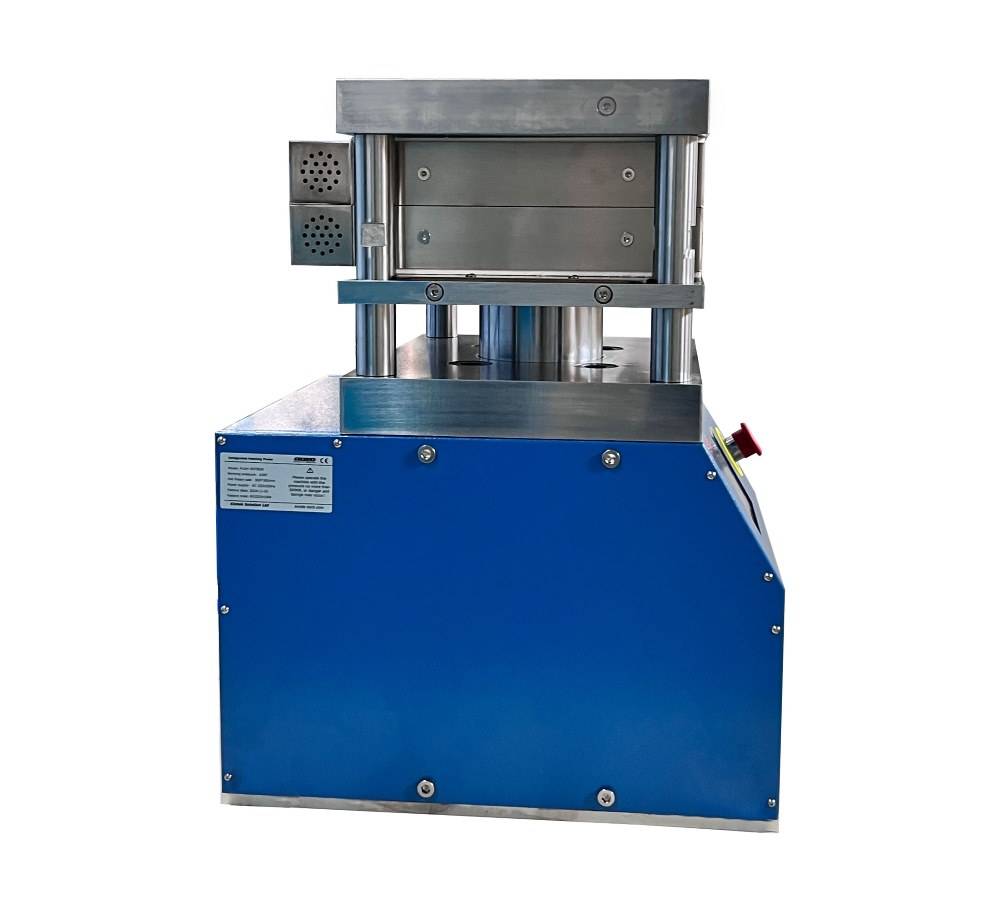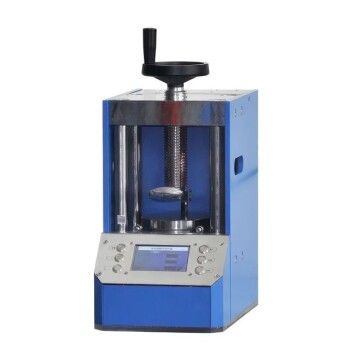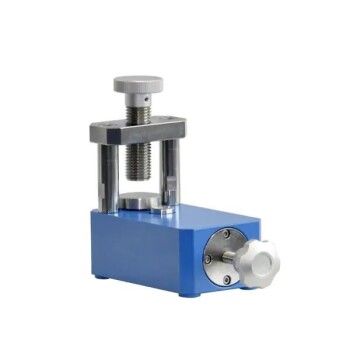
Automatic Heated Lab Press
25T 30T 50T Automatic Heated Hydraulic Press Machine with Heated Plates for Laboratory Hot Press Lab Pellet Press
Item Number : PCAH
Price varies based on specs and customizations
- Working pressure
- 0-50 T
- Heating control
- Digital programmed control
- Heating temperature
- <500 ℃
- Cooling method
- Chiller circulator

Shipping:
Contact us to get shipping details Enjoy On-time Dispatch Guarantee.
Applications
Automatic lab heat press is widely used in material researching labs,pharmacy,catalytic reaction,ceramics, electronic industries, it is one high efficient equipment for the sample preparing, due to its small footprint, it easy to carry and move, can work inside the vacuum glove box for processing under vacuum environment. Hydraulic press can also process hot press function with heating plates, which can serve the particular material processing.
After being heated and pressurized, the chemical stability of the sample particles or powder is improved, which is not easy to be broken and is conducive to cutting and preservation.
Feature
Automatic lab hot press can automatically carry out pressurization, pressure holding and pressure relief procedures, with precise control, suitable for sample preparation with high pressure control requirements. can be heated up to 500°C.
- Fast heating, heating plate can be single side or double side
- Automatically carry out pressurization, pressure holding and pressure relief procedures
- Water circulating fast cooling to protect the press
- Max. Heating temperature is up to 300 ℃
- Small footprint, light weight, easy to carry and move, nice fitting vacuum glove box
Detail & Parts


- Automatic: Fully automatic desktop tablet press, programmable pressurization, easy operation and other advantages, suitable for high-end laboratories.
- Efficiency: Simplify the loading/ejection process. Shorten operating time and improve work efficiency
- Display: LCD screen display, the operation is more intuitive and the display is clearer. Convenient for users to operate.






- When the temperature of the heating plate is air-cooled below 300℃, we can quickly cool the heating plate to room temperature through the water cooling cycle
- When the temperature of the heating plate is higher than 300℃, we need to pass water to the heat insulation plate to protect the temperature of the whole machine from rising.
Advantages
- The upper plate adopts electroplated countersunk head hexagonal screws, beautiful and space-saving
- Chrome-plated cylinder, smooth surface, no rust, good sealing rubber ring, no oil leakage
- One-piece main board structure, oil pool, main board, oil cylinder in a body, no seal connection
- Extended pulling spring, good rebound effect, not easy to deformation, can achieve the cylinder 30mm return without deformation
- All aluminum alloy hand wheel, beautiful, practical, not easy to break
- Small size, light weight, no oil leakage, can be used in the glove box
- Mold using Japanese high-speed steel, good material, high hardness, no deformation, long service life
- Digital display pressure gauge, more accurate pressure control, pressure display accuracy of 0.01MPa
- Oil pool outside the host, easy to replace the oil, and the oil circuit increased the hydraulic oil filtration device
- Special plunger, using special custom sealing structure, excellent sealing effect
- Pressurizing device, placed in the lowermost corner of the mainframe, the angle is reasonable, pressurizing force does not tilt back
Technical specifications
| Instrument Model | PCAH-25T1818/1818G | PCAH-25T2020/2020G | PCAH-30T3030/3030G | PCAH-40T4040/4040G |
|---|---|---|---|---|
| Pressure Range | 0-25.0 tons | 0-25.0 tons | 0-30.0 tons | 0-40.0 tons |
| Pressurization Process | Program pressurization - Program holding - Timed pressure relief | Program pressurization - Program holding - Timed pressure relief | Program pressurization - Program holding - Timed pressure relief | Program pressurization - Program holding - Timed pressure relief |
| Mold Heating Temperature | Room temperature-300.0℃/500.0℃ | Room temperature-300.0℃/500.0℃ | Room temperature-300.0℃/500.0℃ | Room temperature-300.0℃ |
| Insulation Method | lmported insulation board | lmported insulation board | Imported insulation board | Imported insulation board |
| Cooling Method | Quick cooling with water cooling [optional water cooling machine] | Quick cooling with water cooling [optional water cooling machine] | Quick cooling with water cooling [optional water cooling machine] | Quick cooling with water cooling [optional water cooling machine] |
| Hot platen size | 180×180mm(M×N) | 200×200mm(M×N) | 300×300mm(M×N) | 400X400mm(M×N) |
| Dimensions | 300×390×560mm(L×W×H) | 300×390×560mm(L×W×H) | 400×490×580mm(L×W×H) | 500×550×620mm(L×W×H) |
| Powersupply | 1700 W (220V/110V can be customized) | 1700 W(220V/110V can be customized) | 3500 W(220V/110V can be customized) | 5500 W (220V/110V can be customized) |
| Weight | 140 Kg | 140 Kg | 280 Kg | 480 Kg |

Operating steps
How to replace accessories and precautions

Step 1: Place the sample into the heating mold.

Step 2: Press the "Pre pressing" button to clamp the sample between the upper and lower heating plates.

Step 3: Press the "Settings" button to enter the settings menu.

Step 4: Press the "+-" button to set the temperature of the heating plate.

Step 5: Press the "+-" button to set the pressure applied to the sample.

Step 6:Return to the operation menu, press the heating button on the upper and lower boards to start heating them.

Step 7: After the temperature reaches the set temperature, press the pressurization button to start pressurizing the sample at a fixed time.

Step 8: Remove the sample from the mold.
Full range of lab press types

Click to view our full range of lab press products.
Any question? Our experts have helped many laboratories choose their lab press, contact us now!
Full range of types of laboratory press molds
We have a full range of molds for you to choose from, and the molds fit the body perfectly.
If you need molds with special shapes, we can also customize them for you.

Warnings
Operator safety is the top important issue! Please operate the equipment with cautions. Working with inflammable& explosive or toxic gases is very dangerous, operators must take all necessary precautions before starting the equipment. Working with positive pressure inside the reactors or chambers is dangerous, operator must fellow the safety procedures strictly. Extra caution must also be taken when operating with air-reactive materials, especially under vacuum. A leak can draw air into the apparatus and cause a violent reaction to occur.
Designed for You
KinTek provide deep custom made service and equipment to worldwide customers, our specialized teamwork and rich experienced engineers are capable to undertake the custom tailoring hardware and software equipment requirements, and help our customer to build up the exclusive and personalized equipment and solution!
Would you please drop your ideas to us, our engineers are ready for you now!
FAQ
What Is A Lab Press?
What Are The Advantages Of Using A Hydraulically Heated Laboratory Press?
What Are The Applications Of Pellet Presses?
What Is The Purpose Of A Hydraulic Press In Lab?
What Does A Hydraulic Lab Heat Press Do?
How Does A Pellet Press Work?
What Are Different Type Of Lab Presses?
What Is KBr Used For?
What Types Of Samples Or Materials Can Be Processed In A Hydraulically Heated Laboratory Press?
What Are The Benefits Of Using A Pellet Press?
What Is The KBr Pellet Method?
How Does A Hydraulically Heated Laboratory Press Work?
What Factors Should Be Considered When Selecting A Pellet Press?
Why KBr Is Used For Pellet?
How Can The Performance Of A Hydraulically Heated Laboratory Press Be Optimized?
How To Make KBr Pellets For FTIR?
4.8
out of
5
Impeccable product. The automatic heated lab pellet press has significantly improved our lab's productivity.
4.9
out of
5
Automated and accurate. The press has enhanced our laboratory's efficiency, allowing us to allocate more time to other crucial tasks.
4.7
out of
5
Excellent value for money. The press's durability and reliability have been exceptional, making it worth every penny.
4.8
out of
5
The press's technological advancements have revolutionized our research. It has enabled us to achieve higher accuracy and consistency in our experiments.
4.7
out of
5
KINTEK's automatic press is a testament to their commitment to quality. The press's construction and performance are top-notch.
4.9
out of
5
The press's speed and efficiency have been a game-changer for our lab. It has enabled us to expedite our experimental processes significantly.
4.6
out of
5
The ease of use and user-friendly interface of the press have made it a favorite among our lab technicians.
4.8
out of
5
The automatic features and customizable settings have allowed us to tailor the press to our specific research needs.
4.7
out of
5
The press's ability to operate autonomously has freed up our technicians, allowing them to focus on more value-added tasks.
4.9
out of
5
The press's durability has been impressive. It has withstood continuous use in our demanding laboratory environment.
4.8
out of
5
The press's compact design has saved valuable bench space in our crowded laboratory.
4.7
out of
5
The press's versatility has allowed us to conduct a wide range of experiments, making it an indispensable tool in our research.
4.9
out of
5
KINTEK's customer support has been exceptional. They have always been responsive and helpful in addressing any queries or issues.
4.6
out of
5
The press's affordable price point made it an attractive option for our budget-conscious laboratory.
PDF - 25T 30T 50T Automatic Heated Hydraulic Press Machine with Heated Plates for Laboratory Hot Press Lab Pellet Press
DownloadCatalog of Automatic Heated Lab Press
DownloadCatalog of Hydraulic Heated Lab Press
DownloadCatalog of Pellet Press
DownloadCatalog of Lab Press
DownloadCatalog of Kbr Pellet Press
DownloadREQUEST A QUOTE
Our professional team will reply to you within one business day. Please feel free to contact us!
Related Products

Automatic Heated Hydraulic Press Machine with Heated Plates for Laboratory Hot Press
The Automatic High Temperature Heat Press is a sophisticated hydraulic hot press designed for efficient temperature control and product quality processing.

Manual Heated Hydraulic Press Machine with Heated Plates for Laboratory Hot Press
The Manual Heat Press is a versatile piece of equipment suitable for a variety of applications, operated by a manual hydraulic system that applies controlled pressure and heat to the material placed on the piston.

Heated Hydraulic Press Machine with Integrated Manual Heated Plates for Lab Use
Efficiently process heat-pressing samples with our Integrated Manual Heated Lab Press. With a heating range up to 500°C, it's perfect for various industries.

Automatic Laboratory Hydraulic Pellet Press Machine for Lab Use
Experience efficient sample preparation with our Automatic Lab Press Machine. Ideal for material research, pharmacy, ceramics, and more. Features a compact size and hydraulic press functionality with heating plates. Available in various sizes.

Laboratory Manual Hydraulic Pellet Press for Lab Use
Efficient sample preparation with small footprint Manual Lab Hydraulic Press. Ideal for material researching labs, pharmacy, catalytic reaction, and ceramics.

Heated Hydraulic Press Machine with Heated Plates Split Manual Laboratory Hot Press
Efficiently prepare your samples with our Split Manual Heated Lab Press. With a pressure range up to 40T and heating plates up to 300°C, it's perfect for various industries.

Heated Hydraulic Press Machine with Heated Plates for Vacuum Box Laboratory Hot Press
Enhance your lab's precision with our lab press for vacuum box. Press pills and powders with ease and precision in a vacuum environment, reducing oxidation and improving consistency. Compact and easy to use with a digital pressure gauge.

Heated Hydraulic Press Machine with Heated Plates for Vacuum Box Laboratory Hot Press
The lab press for vacuum box is a specialized piece of equipment designed for laboratory use. Its main purpose is to press pills and powders according to specific requirements.

Electric Heated Hydraulic Vacuum Heat Press for Lab
The Electric Vacuum Heat Press is a specialized heat press equipment that operates in a vacuum environment, utilizing advanced infrared heating and precise temperature control for high quality, rugged and reliable performance.

Laboratory Hydraulic Press Lab Pellet Press Machine for Glove Box
Controlled environment lab press machine for glove box. Specialized equipment for material pressing and shaping with high precision digital pressure gauge.

30T 40T Split Automatic Heated Hydraulic Press Machine with Heated Plates for Laboratory Hot Press
Discover our split automatic heated lab press 30T/40T for precise sample preparation in material research, pharmacy, ceramics, and electronics industries. With a small footprint and heating up to 300°C, it's perfect for processing under vacuum environment.

Laboratory Manual Hydraulic Pellet Press for Lab Use
Efficient Manure Lab Hydraulic Press with Safety Cover for sample preparation in material research, pharmacy, and electronic industries. Available in 15T to 60T.

Laboratory Hydraulic Pellet Press for XRF KBR FTIR Lab Applications
Efficiently prepare samples with the Electric Hydraulic Press. Compact and portable, it's perfect for labs and can work in a vacuum environment.

Laboratory Hydraulic Press Split Electric Lab Pellet Press
Efficiently prepare samples with a split electric lab press - available in various sizes and ideal for material research, pharmacy, and ceramics. Enjoy greater versatility and higher pressure with this portable and programmable option.

Laboratory Hydraulic Press Lab Pellet Press for Button Battery
Efficiently prepare samples with our 2T Button Battery Press. Ideal for material research labs and small-scale production. Small footprint, lightweight, and vacuum-compatible.

Laboratory Hydraulic Press Lab Pellet Press KBR Pellet Press 2T FTIR Press
Introducing the KINTEK KBR Press - a handheld laboratory hydraulic press designed for entry-level users.

Vacuum Hot Press Furnace Machine for Lamination and Heating
Experience clean and precise lamination with Vacuum Lamination Press. Perfect for wafer bonding, thin-film transformations, and LCP lamination. Order now!

Explore versatile Hydraulic Hot Press molds for precise compression molding. Ideal for creating various shapes and sizes with uniform stability.

Vacuum Hot Press Furnace Heated Vacuum Press Machine Tube Furnace
Reduce forming pressure & shorten sintering time with Vacuum Tube Hot Press Furnace for high-density, fine-grain materials. Ideal for refractory metals.
Related Articles

Optimizing Laboratory Analysis with Split Automatic Heated Lab Pellet Press
Explore the advanced features and benefits of split automatic heated lab pellet presses for precise pellet preparation in various analytical applications. Ideal for high-throughput laboratories.

Automatic flat plate heat press operating steps

Operating of Automatic Lab xrf Pellet Press
How to use the Automatic Lab xrf Pellet Press, including steel ring, plastic ring, boric acid mold

Comprehensive Guide to Integrated Manual Heated Lab Pellet Presses
Explore the features and applications of integrated manual heated lab pellet presses. Learn about customization options, capacities, and benefits for spectroscopy and analysis.

Automatic Hydraulic Press: The Ultimate Guide for Efficient Sample Preparation and Industrial Processes
Discover the world of automatic hydraulic presses, from their versatile applications in industrial XRF and laboratory sample manipulation to their role in large-scale manufacturing, hot embossing, laminating, and polymer melting. Learn about their benefits, features, and how they revolutionize sample preparation and industrial processes.

How Much Pressure Do You Need in a Heated Lab Press
Lab presses are versatile and essential tools that are used in various laboratory applications.

How to choose a laboratory hot press
The laboratory hot pressing machine is suitable for laboratory users who are strict about sample pressing temperature, pressure control accuracy and need a wide size mold for pressing samples. The new lab hot press of KINDLE TECH has a double-plate structure and a pressing force of 0~40 tons.

Manual Hydraulic Pellet Press: An Efficient Tool for Spectral Analyses Preparation
The manual hydraulic pellet press offers several key features that make it a valuable tool for laboratory applications. Some of the main features include:Availability of pressing tools in different diameters: 40mm, 32mm, and 15mm;Availability of pressing tools in different diameters: 40mm, 32mm, and 15mm;Designed pressure force display in 10 kN steps;Ease of operation via hand lever;Convenience in cleaning;Single-stage piston stroke of maximum 25mm ect.

A Comprehensive Guide on Pressing XRF Pellets Using a KinTek Automatic Hydraulic Press
XRF (X-ray fluorescence) analysis is a powerful technique used in various industries for material analysis. One crucial step in the XRF analysis process is the preparation of high-quality XRF pellets. These pellets serve as the sample for analysis and need to be properly pressed to ensure accurate results.

Fully automatic tablet press operating steps and replacement accessories
Relevant introduction to the operating steps and replacement accessories of the fully automatic tablet press

How to Maintain Manual Lab Hot Press Machine
Maintenance of manual hot press: Keep flat and clean, Clean the upper and lower linings, Pad the fiberboard

Applications and Importance of Hydraulic Press in Laboratories
A hydraulic press is a machine that uses the pressure generated in a confined fluid to configure metals, plastics, rubber, and other materials. Its operation is governed by Pascal’s principle, which states that pressure applied to a confined fluid is transmitted unaltered throughout the fluid.